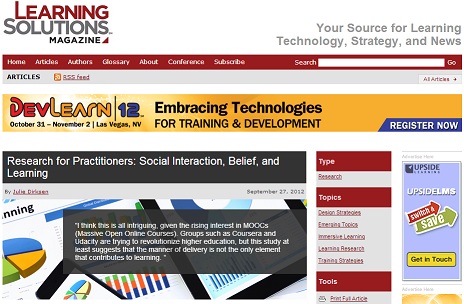So the first column of what will hopefully be a longish running series for the elearning guild is up — it’s an effort to make learning-related academic research more available to a professional practitioner audience:
Here’s the story behind it:
Several months ago, Clark Quinn and I were at a workshop and we were discussing the problem of evidence-based practice. We agreed that staying connected with academic research was a critical activity for instructional designers, but we both recognized that it was really hard to do. Busy practitioners just don’t have time to sit down and read all the way through the latest copy of BJET (the British Journal of Educational Technology).
The Internet is a mixed blessing in this regard—a huge number of journal articles are freely available online, but the academic publishers are firewalling them more frequently these days. And even if you can get access to articles—who has time to read them?
This Learning Solutions article is the first in a series intended to address this problem. This series will present short summaries of academic research that may be of interest to eLearning designers. The Learning Solutions article authors (there are several of us) will offer a short, blog-length summary of each study and include a brief discussion of the implications for design. Some of the journal articles we summarize will be newly released research, and some will be older studies that we think still have implications for eLearning design.
We are very interested in your feedback—we want to know whether this is helpful to you as a practitioner? Let us know what you think—please leave your reactions in the comments following the article!


Great idea! I’m glad it came to fruition.
Hey cool. Thanks for posting about this.
¡Muy buena idea!, será de gran ayuda. Great idea!, it will be very helpful
Staying current with learning research like this is the hardest part of my job.
This is a great idea. Glad you are doing it. In regards to this particular research, it actually seems to support some of the naysayers of eLearning. I believe most of that comes from the industry’s early attempts which were mostly text based screens with very little stimulation for the end user. It’s a hole we now have to dig ourselves out of unfortunately but research such as this is a tool that can help all of us do that. Thanks for sharing and I can’t wait to see more.